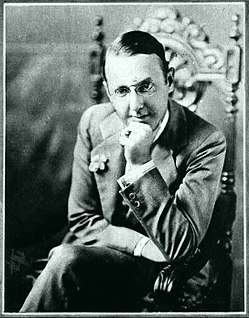Gateway to Hollywood
Gateway to Hollywood is an American old-time radio talent show. It was broadcast on CBS from January 8, 1939, to December 31, 1939.[1] Like other programs from Major Bowes Amateur Hour to American Idol, the show sought to turn relatively unknown people into celebrities.[2] The same title was used by an unrelated program that was broadcast on the Don Lee Network in the mid-1930s.[3]
 Jesse L. Lasky, host of Gateway to Hollywood | |
| Genre | Talent show |
|---|---|
| Country of origin | United States |
| Language(s) | English |
| Syndicates | CBS |
| Hosted by | Jesse L. Lasky |
| Announcer | Ken Niles Cliff Howell Gary Breckner |
| Written by | Ray Wilson |
| Directed by | Charles Vanda Jesse L. Lasky |
| Produced by | Bobby Brown |
| Original release | January 8, 1939 – December 31, 1939 |
| Sponsored by | Wrigley's gum |
Format
Cities across the United States were sites for auditions for people who wanted to appear on Gateway to Hollywood. Contestants auditioned in teams of one male and one female, with the ultimate winning team receiving a screen test from RKO Pictures.[4] In addition to the screen test, each member of the winning couple received membership in the Screen Actors Guild and screen names that they would use in their acting careers. Judges were five people from RKO, with criteria for selection being "photographic potential, personality, and dramatic ability."[1] Wrigley's gum was the sponsor.[1]
Contestant teams that survived early elimination and appeared on the program performed a playlet with a well-known star. Each round of competition involved 13 teams and lasted 13 weeks,[5]
Personnel
Film producer Jesse L. Lasky was the host of Gateway to Hollywood.[1] Ken Niles was the chief announcer and talent coach. Assistant announcers were Cliff Howell and Gary Breckner. Charles Vanda was the initial director, with Lasky taking over that role when the series resumed in the fall of 1939. Ray Wilson was the head writer. Bobby Brown was the producer.[6] Wilbur Hatch and Carl Hohengarten provided the music.[1]
Selected participants
Winners
- Ralph Bowman received a contract with RKO and the screen name John Archer.[2]
- Josephine Cottle became actress Gale Storm. She later married her Gateway to Hollywood teammate, Lee Bonnell, who took the screen name Terry Belmont.[1]
Don Lee Network program
Beginning in 1936, the Don Lee Network broadcast a program titled Gateway to Hollywood on the West Coast. It used an amateur-hour format but featured "tried and experienced professional entertainers" who hoped the exposure would give them an opportunity to get into film, radio, or other fields of entertainment.[3] Approximately a dozen acts competed on each broadcast; members of the audience selected each winner with votes submitted via telephone and mail.[3]
References
- Dunning, John (1998). On the Air: The Encyclopedia of Old-Time Radio (Revised ed.). New York, NY: Oxford University Press. pp. 279-280. ISBN 978-0-19-507678-3. Retrieved 2019-10-23.
- Loviglio, Jason (2005). Radio's Intimate Public: Network Broadcasting and Mass-mediated Democracy. U of Minnesota Press. p. 123. ISBN 9780816642342. Retrieved 22 December 2017.
- "'Gateway to Hollywood'" (PDF). Billboard. April 18, 1936. p. 9.
- Davis, Ronald L. (2014). Hollywood Beauty: Linda Darnell and the American Dream. University of Oklahoma Press. pp. 36–38. ISBN 9780806186962. Retrieved 22 December 2017.
- Terrace, Vincent (1999). Radio Programs, 1924-1984: A Catalog of More Than 1800 Shows. McFarland & Company, Inc. p. 535. ISBN 978-0-7864-4513-4.
- "Wrigley Autumn Series Continues RKO Tieup" (PDF). Broadcasting. October 1, 1939. p. 16. Retrieved 23 December 2017.
- "'Gateway to Hollywood' Shut But Back Door Is Still Open" (PDF). Billboard. October 21, 1939. p. 4. Retrieved 23 December 2017.
- Fitzgerald, Michael G.; Magers, Boyd (2006). Ladies of the Western: Interviews with Fifty-One More Actresses from the Silent Era to the Television Westerns of the 1950s and 1960s. McFarland. pp. 9–13. ISBN 9780786426560. Retrieved 30 October 2016.
- "Behind the Mike" (PDF). Broadcasting. May 15, 1939. p. 46. Retrieved 23 December 2017.
- "Sac City girl steps toward film stardom". The Des Moines Register. June 4, 1939. p. 47. Retrieved June 28, 2020 – via Newspapers.com.